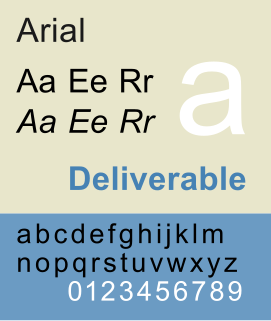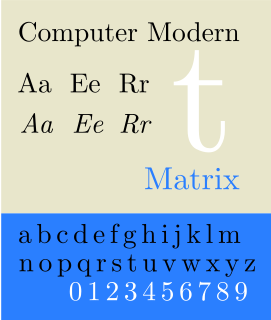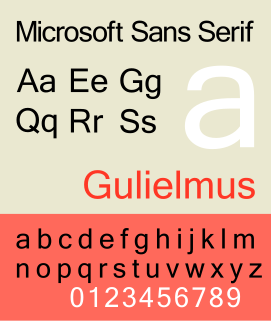External links
- Unihan font, described by Roman Czyborra.
Unihan font was developed by Ross Paterson in 1993.
Unihan font had two variations, 16×16 and 24×24 bitmap fonts. These covered most of the CJK Auxiliary and Unihan portions of Unicode 1.1. Font files were in HBF (and bin) format (BDF). The bitmaps in bin files were derived from GB 2312, Big5, JIS X 0208, KSC 5601 (now called KS X 1001) and CCCII fonts.

A typeface is the design of lettering that can include variations in size, weight, slope, width, and so on. Each of these variations of the typeface is a font.
Han unification is an effort by the authors of Unicode and the Universal Character Set to map multiple character sets of the Han characters of the so-called CJK languages into a single set of unified characters. Han characters are a feature shared in common by written Chinese (hanzi), Japanese (kanji), Korean (hanja) and Vietnamese.

Arial is a sans-serif typeface and set of computer fonts in the neo-grotesque style. Fonts from the Arial family are included with all versions of Microsoft Windows from Windows 3.1 on, some other Microsoft software applications, Apple's macOS and many PostScript 3 computer printers. The typeface was designed in 1982, by Robin Nicholas and Patricia Saunders, for Monotype Typography. Each of its characters has the same width as that character in the popular typeface Helvetica; the purpose of this design is to allow a document designed in Helvetica to be displayed and printed with the intended line-breaks and page-breaks without a Helvetica license. Because of their almost identical appearances, both Arial and Helvetica have commonly been mistaken for one another.

Tahoma is a humanist sans-serif typeface that Matthew Carter designed for Microsoft Corporation. Microsoft first distributed it, along with Carter's Verdana, as a standard font in the initial release of Windows 95.

Computer Modern is the original family of typefaces used by the typesetting program TeX. It was created by Donald Knuth with his Metafont program, and was most recently updated in 1992. Computer Modern, or variants of it, remains very widely used in scientific publishing, especially in disciplines that make frequent use of mathematical notation.

Apple Inc. uses a large variety of typefaces in its marketing, operating systems, and industrial design with each product cycle. These change throughout the years with Apple's change of style in their products. This is evident in the design and marketing of the company.

Lucida is an extended family of related typefaces designed by Charles Bigelow and Kris Holmes and released from 1984 onwards. The family is intended to be extremely legible when printed at small size or displayed on a low-resolution display – hence the name, from 'lucid'.
A computer font is implemented as a digital data file containing a set of graphically related glyphs. A computer font is designed and created using a font editor. A computer font specifically designed for the computer screen, and not for printing, is a screen font.

There are Unicode typefaces which are open-source and designed to contain glyphs of all Unicode characters, or at least a broad selection of Unicode scripts. There are also numerous projects aimed at providing only a certain script, such as the Arabeyes Arabic font. The advantage of targeting only some scripts with a font was that certain Unicode characters should be rendered differently depending on which language they are used in, and that a font that only includes the characters a certain user needs will be much smaller in file size compared to one with many glyphs. Unicode fonts in modern formats such as OpenType can in theory cover multiple languages by including multiple glyphs per character, though very few actually cover more than one language's forms of the unified Han characters.
A fallback font is a reserve typeface containing symbols for as many Unicode characters as possible. When a display system encounters a character that is not part of the repertoire of any of the other available fonts, a symbol from a fallback font is used instead. Typically, a fallback font will contain symbols representative of the various types of Unicode characters.
Meiryo is a Japanese sans-serif gothic typeface. Microsoft bundled Meiryo with Office Mac 2008 as part of the standard install, and it replaces MS Gothic as the default system font for Vista on Japanese systems.
A Unicode font is a computer font that maps glyphs to code points defined in the Unicode Standard. The vast majority of modern computer fonts use Unicode mappings, even those fonts which only include glyphs for a single writing system, or even only support the basic Latin alphabet. Fonts which support a wide range of Unicode scripts and Unicode symbols are sometimes referred to as "pan-Unicode fonts", although as the maximum number of glyphs that can be defined in a TrueType font is restricted to 65,535, it is not possible for a single font to provide individual glyphs for all defined Unicode characters. This article lists some widely used Unicode fonts that support a comparatively large number and broad range of Unicode characters.
Unihan is an effort by Unicode/ISO 10646 to map Han characters into a single set, ignoring regional variations.
Apple's Macintosh computer supports a wide variety of fonts. This support was one of the features that initially distinguished it from other systems.

Microsoft Sans Serif is a TrueType font introduced with early Windows versions. It is the successor of MS Sans Serif, a proportional bitmap font introduced in Windows 1.0. Both fonts are very similar in design to Arial and Helvetica. This font was made to match the MS Sans bitmap included in the early releases of Microsoft Windows.

Radical 213 meaning "turtle" is one of only two of the 214 Kangxi radicals that are composed of 16 strokes.

GNU Unifont is a free Unicode bitmap font using an intermediate bitmapped font format created by Roman Czyborra. The main Unifont covers all of the Basic Multilingual Plane (BMP). The "upper" companion covers significant parts of the Supplementary Multilingual Plane (SMP). The "Unifont JP" companion contains Japanese kanji present in the JIS X 0213 character set.

WenQuanYi is an open-source project of Chinese computer fonts licensed under GNU General Public License.